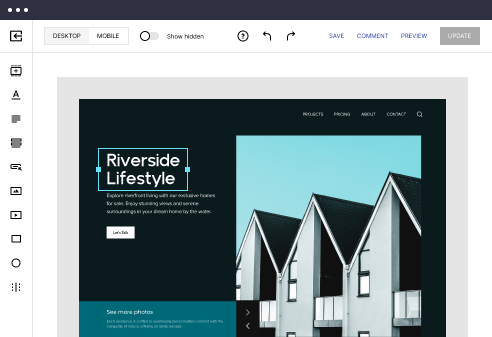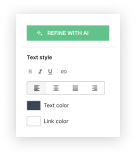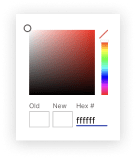
HTML/CSS optimized search engine template
Explore Similar TemplatesAbout template
Leverage our intuitive page builder and high-converting HTML/CSS optimized search engine template.
Recommended templates
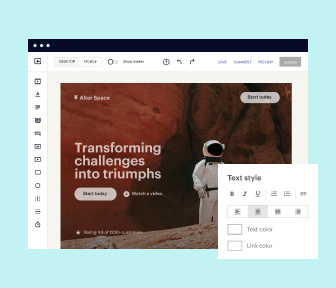
Easy to build without coding
With the intuitive drag-and-drop builder, anyone on your team can create high-converting pages without any knowledge of code or design. Make enhancements to your landing page with custom widgets using Javascript, HTML/CSS, or third-party scripts.
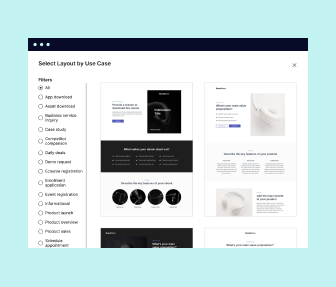
Multiple layouts for any industry and goal
Select from 500+ landing page layouts built to boost conversions across industry-specific scenarios. Customize them by adjusting fonts, adding images, and generating on-brand content with the AI assistant. Quickly scale with Instablocks® and Global Blocks that you can save, reuse, and update globally.
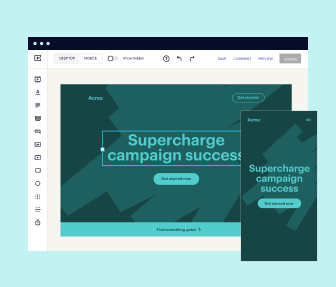
Loads fast and looks polished on any device
Every template is responsive, which means they present professionally on any device and load blazingly fast with our Thor Render Engine. You can also power them up with Google AMP technology to deliver an unparalleled mobile experience and drive higher conversions.
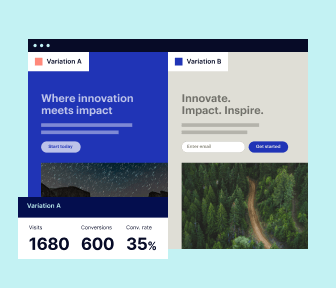
Robust analytics & experimentation
Get real-time updates and reporting across all your devices, showing the number of visitors, conversions, cost-per-visitor, and cost-per-lead. Launch AI-powered experiments, run A/B tests, and use heatmaps to analyze user behavior, then optimize your landing page to maximize conversions.

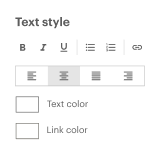
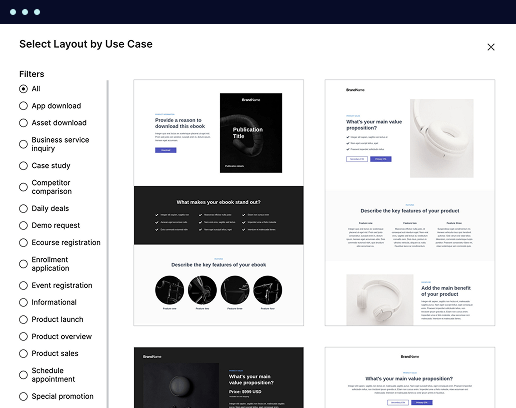
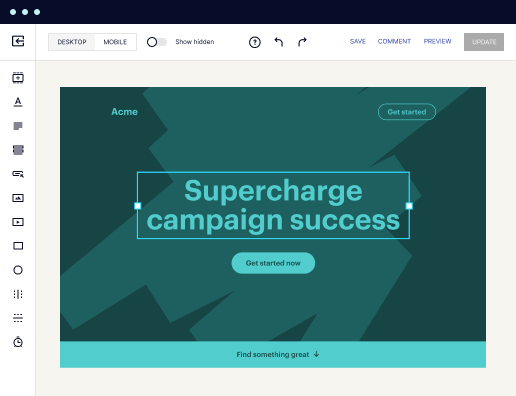

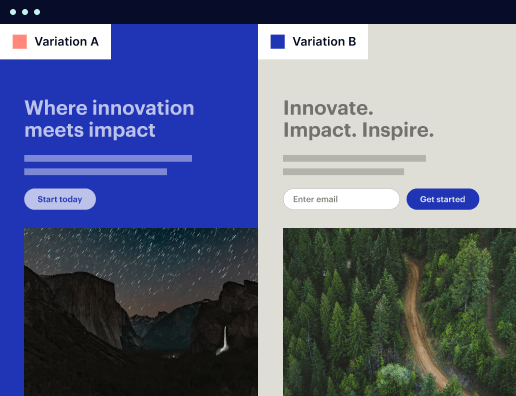

Easy to build without coding
With the intuitive drag-and-drop builder, anyone on your team can create high-converting pages without any knowledge of code or design. Make enhancements to your landing page with custom widgets using Javascript, HTML/CSS, or third-party scripts.
Multiple layouts for any industry and goal
Select from 500+ landing page layouts built to boost conversions across industry-specific scenarios. Customize them by adjusting fonts, adding images, and generating on-brand content with the AI assistant. Quickly scale with Instablocks® and Global Blocks that you can save, reuse, and update globally.
Loads fast and looks polished on any device
Every template is responsive, which means they present professionally on any device and load blazingly fast with our Thor Render Engine.
Robust analytics & experimentation
Get real-time updates and reporting across all your devices, showing the number of visitors, conversions, cost-per-visitor, and cost-per-lead. Launch AI-powered experiments, run A/B tests, and use heatmaps to analyze user behavior, then optimize your landing page to maximize conversions.
All the features you need to build search engine template
Explore more featuresLearn how to build search engine design templates
Frequently asked questions about search engine website template
Leading the way in building high-performing landing pages





Search engine html template: Your ultimate how-to guide
Instapage is the most powerful landing page and conversion rate optimization (CRO) platform available today. It provides marketers across various sectors, including business services, education, and tech, with the tools necessary to accelerate and optimize their digital marketing campaigns. This guide will walk you through the process of maximizing your marketing ROI through effective use of Instapage's features.
Understanding landing pages
Landing pages are standalone web pages created specifically for marketing or advertising campaigns. They serve a single purpose: to convert visitors into leads or customers. By utilizing a flexible and easy-to-use landing page creation platform like Instapage, marketers can launch effective campaigns quickly without the need for extensive coding skills. This is particularly valuable for teams with varying levels of technical expertise.
Steps to create your first landing page
Creating a landing page on Instapage is a straightforward process that can be broken down into key steps:
- Select a template: Choose from 100+ high-converting templates specifically designed for various industries and campaign goals.
- Customize your page: Utilize the intuitive drag-and-drop builder to add lead generation elements and tailor content to your audience.
- Launch your page: With a few clicks, publish your landing page and start capturing leads.
Optimizing your landing pages for success
Once your landing page is live, optimization becomes crucial for maximizing conversions. Instapage offers features that help you:
- Use A/B testing: Continually test variations of your landing page to determine which elements resonate most with your audience.
- Analyze performance: Leverage Instapage's analytics dashboard to track engagement metrics and make informed adjustments.
- Implement heatmaps: Understand user behavior on your pages to identify areas needing improvement.
Personalizing the user experience
To enhance engagement and boost conversion rates, consider personalization strategies. Instapage allows you to:
- Dynamically replace text based on visitor data, creating a tailored experience.
- Align ads with specific landing pages using AdMaps to maintain messaging consistency.
- Track audience-level metrics to continually refine your approach and cater to distinct audience segments.
In conclusion, employing Instapage to create optimized landing pages is essential for effective digital marketing. With its comprehensive tools, marketers can easily improve campaign performance and achieve higher conversion rates.
Ready to transform your marketing efforts? Start using Instapage today to create landing pages that captivate and convert.
People also ask about HTML/CSS optimized search engine template
HTML/CSS optimized search engine template
Understanding HTML/CSS optimized search engine templates
In the realm of web development, HTML and CSS optimized templates have become foundational tools. These templates not only simplify the creation process of web pages but also serve critical functions in enhancing visibility on search engines. Their design and structure can significantly affect how well a website ranks in search results, making it essential for marketers and developers to understand their role and implementation.
The essence of HTML/CSS templates in modern web development
HTML/CSS templates are pre-designed layouts that use HTML for structure and CSS for styling. These templates are important as they provide a ready-made foundation for creating web pages, ensuring consistent design and functionality. Moreover, they enable quicker development cycles, allowing businesses to get their products or services online with less time and effort.
The role of templates in SEO has evolved significantly. Initially viewed as mere design tools, they now include features that enhance search engine visibility, such as clean code, mobile responsiveness, and fast loading times. As the digital landscape changes, developers are rethinking how templates function, ensuring they address not only aesthetic needs but also performance and optimization for search engines.
The evolution of templates reflects the changing needs of web users. From basic designs that catered only to aesthetic considerations, templates have transformed into complex structures that incorporate behavior, interaction, and SEO best practices. This transition showcases the importance of HTML/CSS templates in creating websites that are both visually appealing and technically sound.
Key features of an optimized search engine template
A well-designed HTML/CSS optimized search engine template encompasses several key features that collectively enhance its performance in search engines. First and foremost is responsive design, which ensures that the layout adapts seamlessly to various screen sizes.
Importance of mobile-friendliness: With an increasing number of users accessing websites on mobile devices, search engines reward mobile-friendly sites with higher rankings.
CSS media queries: These make it possible to change the styling of the template based on device characteristics, enhancing user experience.
Another critical aspect is fast load times. Search engines prefer fast-loading websites, as they provide a better user experience. Optimized code plays a significant role here, ensuring that the template loads quickly by eliminating unnecessary elements and minimizing file sizes.
Role of optimized code: Clean and efficient code reduces server response time, leading to improved load speed.
Utilizing lazy loading for images: This technique defers loading of images until they are in the viewport, which can significantly improve initial load times.
Lastly, clean and structured HTML is paramount. Using semantic HTML elements improves accessibility and helps search engines understand the content of the page better. A well-structured Document Object Model (DOM) leads to efficient rendering, which further contributes to SEO performance.
Building your template: A guide to the template builder
Building an HTML/CSS optimized search engine template can be streamlined with a well-designed template builder. This guide provides a step-by-step approach to effectively utilize such a tool.
Selecting a base layout: Begin by choosing a layout that fits the content type and desired user experience, considering various column and grid systems.
Customizing header and footer: The header should encapsulate branding elements like logos and navigation, while the footer can include essential contact information and links.
Incorporating design elements: Selecting a color scheme that aligns with brand identity and using consistent typography can significantly impact user engagement.
Beyond structure, adding functional components completes the template. Integrating engaging elements such as videos can enhance the user experience. Additionally, ensuring easy navigation through clear menu links helps keep users on the website longer, reducing bounce rates.
Enhancements through JavaScript functions
JavaScript functions can significantly enhance the performance of a search engine template. One effective method is leveraging the Document.addEventListener to create better interactivity.
Events to enhance user experience: Use event listeners to manage user interactions, such as clicks or keyboard actions, leading to a more engaging environment.
Examples of common event listeners: Click events for buttons, form submission events, and mouse hover effects can make the interface feel more responsive.
Functions that focus on load time optimization are equally essential. Efficient scripting—such as reducing redirect chains and minimizing HTTP requests—can lead to better performance. Utilizing asynchronous functions allows scripts to load in parallel without blocking other resources, further boosting speed.
Best practices for content creation in templates
Creating content for an optimized search engine template should prioritize SEO considerations. Crafting SEO-optimized content involves focusing on metadata and keyword placement. Properly using keywords in headings and throughout the body increases the likelihood of ranking higher in search results.
Importance of metadata: Meta titles, descriptions, and alt attributes for images play a critical role in SEO.
Structuring content: Using headings and subheadings creates a clear hierarchy, making content easier to digest and navigate.
While images enhance visual appeal, they can also pose risks if not managed correctly. Balancing aesthetics and performance is vital. Proper image formats like JPEG or PNG, along with compression techniques, ensure that images do not hinder loading speeds.
Identifying and overcoming common problems
Even well-crafted HTML/CSS optimized templates can encounter problems. Troubleshooting layout issues is often necessary. Common CSS problems include forgotten properties or misspellings, which can be resolved quickly if identified early.
Common CSS problems: Use browser developer tools to detect and fix issues such as layout shifts or misplaced elements.
Ensuring cross-browser compatibility: Test your template across different browsers to catch discrepancies in rendering.
Enhancing SEO performance requires constant vigilance. Slow load times could hurt rankings, especially if unoptimized elements are present. Recognizing these issues and proactively adjusting strategies can make a significant difference. Additionally, navigating common SEO pitfalls, such as keyword stuffing or neglecting mobile optimization, are crucial in maintaining a robust online presence.
Testing and iterating your template
Continuous testing and iteration are vital for optimizing your HTML/CSS template. Understanding document.ready and DOMContentLoaded events is essential for managing loading states effectively. These concepts help determine when the page is fully interactive and can improve user experience.
Techniques for debugging: Utilize console logs and error-catching methods to find and fix issues within your templates.
Collecting and implementing user feedback: Learning from user experiences guides further iterations and improvements.
A/B testing different template elements can yield valuable insights. Trying out various versions of buttons, layouts, or even content types allows marketers to analyze what resonates best with their audience. Gathering analytics through user behavior helps inform future changes and optimizations, ensuring that the template continues to meet evolving needs.
Future trends in HTML/CSS templates for SEO
As web technology and user preferences evolve, so does the landscape of HTML/CSS optimized search engine templates. Innovative design trends are currently shifting towards minimalism, emphasizing clean lines and ample white space for better visual hierarchy.
Predicted changes in algorithms: Search engines will likely continue to evolve, with a stronger focus on user experience metrics and mobile optimization.
The role of artificial intelligence in template design: AI tools are increasingly assisting in automating design elements and enhancing personalization features.
Keeping an eye on these trends is vital for marketers looking to maintain competitive edge. Adaptation to evolving technologies and user expectations can lead to templates that not only perform well but also provide an outstanding user experience.
Real-world case studies: Successful implementations
Numerous businesses have successfully utilized optimized HTML/CSS templates to boost their online presence. For instance, a tech startup revamped its landing page with a well-structured template, resulting in increased page speed and enhanced SEO performance.
Documenting changes before and after implementation: Analyzing traffic patterns pre- and post-implementation provides insight into the effectiveness of the changes.
Specific metrics: Tracking improvements in traffic and conversion rates offers quantifiable data to assess the template’s success.
Lessons learned from these case studies highlight the importance of continuous improvement and adaptation. Understanding user behavior and feedback is crucial for refining templates and achieving business objectives effectively.
Ready to skyrocket conversions?
Supercharge your ad campaigns with high-performing landing pages
Get started